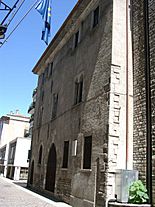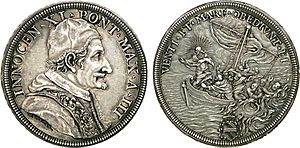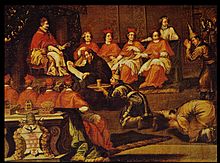Pope Innocent XI facts for kids
Quick facts for kids Pope Blessed Innocent XI |
|
|---|---|
| Bishop of Rome | |
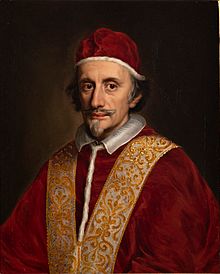
Portrait by Jacob Ferdinand Voet, 1670s
|
|
| Church | Catholic Church |
| Papacy began | 21 September 1676 |
| Papacy ended | 12 August 1689 |
| Predecessor | Clement X |
| Successor | Alexander VIII |
| Orders | |
| Ordination | 20 November 1650 |
| Consecration | 29 January 1651 by Francesco Maria Macchiavelli |
| Created Cardinal | 6 March 1645 |
| Personal details | |
| Birth name | Benedetto Odescalchi |
| Born | 16 May 1611 Como, Lombardy, Duchy of Milan |
| Died | 12 August 1689 (aged 78) Rome, Papal States |
| Previous post |
|
| Motto | Avarus non implebitur ("The covetous man is not (never) satisfied [with money]") |
| Coat of arms | |
| Sainthood | |
| Feast day |
|
| Venerated in | Catholic Church |
| Title as Saint | Blessed |
| Beatified | 7 October 1956 Saint Peter's Basilica, Vatican City by Pope Pius XII |
| Attributes |
|
| Patronage |
|
| Other Popes named Innocent | |
Pope Innocent XI (born Benedetto Odescalchi) was the leader of the Catholic Church and the ruler of the Papal States from 1676 until his death in 1689. He was born on May 16, 1611, and passed away on August 12, 1689.
During his time as Pope, Innocent XI faced many challenges, especially with King Louis XIV of France. He worked hard to improve the Papal States by lowering taxes and managing money carefully. He also tried to stop favoritism (nepotism) within the Church. Innocent XI was known for living simply and encouraging others to do the same. He focused on making the Church's administration and moral standards better.
He is remembered for his support in freeing Hungary from Turkish rule, which is why he is sometimes called the "Saviour of Hungary" there. After his death, he was declared "Blessed" by Pope Pius XII in 1956.
Contents
Early Life and Career
Benedetto Odescalchi was born in Como, Italy, on May 16, 1611. His father was Livio Odescalchi, a nobleman, and his mother was Paola Castelli Giovanelli. Benedetto had several brothers and sisters.
His family, the Odescalchi, were known for their business skills. In 1619, Benedetto's brother and uncles started a successful money-lending bank in Genoa. When he was 15, Benedetto moved to Genoa to learn about the family business. They traded with important cities across Europe, like Nuremberg and Rome.
In 1626, Benedetto's father died. He then studied with the Jesuits in Genoa. In 1630, he survived a serious outbreak of plague, but his mother sadly passed away.
Between 1632 and 1636, Benedetto decided to study law in Rome and Naples. This led him to important roles in the Church, including governor of Macerata. In 1645, Pope Innocent X made him a Cardinal. He later became a special representative (legate) in Ferrara. When he helped the people of Ferrara during a severe famine, the Pope called him the "father of the poor."
In 1650, Odescalchi became the bishop of Novara. He used all the money from his position to help the poor and sick in his area. He later resigned as bishop in 1656 and moved back to Rome, where he took part in important Church meetings.
Becoming Pope
The Papal Election
Benedetto Odescalchi was a strong choice for Pope after Pope Clement IX died in 1669. However, the French government did not want him to be Pope at that time.
When Pope Clement X died in 1676, King Louis XIV of France again tried to stop Odescalchi from being elected. But the cardinals and the people of Rome strongly wanted Odescalchi as their Pope. So, King Louis reluctantly agreed.
On September 21, 1676, Odescalchi was chosen as the new Pope and took the name Innocent XI. He chose this name to honor Pope Innocent X, who had made him a cardinal. He was officially crowned Pope on October 4, 1676.
| Papal styles of Pope Innocent XI |
|
|---|---|
 |
|
| Reference style | His Holiness |
| Spoken style | Your Holiness |
| Religious style | Holy Father |
| Posthumous style | Blessed |
Improving the Church's Management
As soon as he became Pope, Innocent XI worked to cut down on the Church's spending. He made strict rules against nepotism, which is when people in power give jobs to family members. He lived very simply and asked the cardinals to do the same. Because of his careful spending, he not only fixed the Church's yearly budget problems but also created a surplus of money within a few years.
He quickly showed his dedication to improving behavior and fixing problems in how the Church was run. He started with the clergy (priests and religious leaders) and then encouraged everyone to live by higher moral standards. He closed all theaters in Rome, believing they led to bad behavior. He also temporarily stopped Roman opera performances.
In 1679, he publicly spoke out against 65 ideas about morality, saying they were wrong. He especially condemned a way of thinking that allowed people to deceive others without directly lying.
Relations with Jewish Communities
Innocent XI showed kindness in his dealings with Jewish people in Italy. He made the city of Venice release Jewish prisoners in 1685. He also tried to discourage forced baptisms, which became less common during his time.
However, in 1682, he issued an order to stop all money-lending activities by Roman Jews. This rule would have helped his own brothers, who were also involved in money-lending. But after realizing this would cause great hardship, he delayed the rule twice.
Foreign Relations
The Battle of Vienna
Innocent XI was a strong supporter of the Holy League, an alliance that brought together German leaders and King John III Sobieski of Poland. In 1683, this alliance helped save Vienna when it was under attack by the Turks.
After Vienna was saved, Innocent XI worked hard to convince Christian leaders to help drive the Turks out of Hungary. He gave millions of scudi (money) to the war effort in Austria and Hungary. He lived to see the capture of Belgrade from the Turks in 1688.
Pope-Burning in London
During a time in England (1679-1681) when Parliament wanted to prevent the Catholic Duke of York from becoming king, some radical Protestants in London held large parades. These parades often ended with burning a dummy of "The Pope."
The people organizing these events did not know that the actual Pope in Rome was having serious disagreements with the King of France. So, the Pope was actually not supporting the Duke of York becoming king, which was something King Louis XIV wanted.
Relations with France
Innocent XI's time as Pope was marked by a struggle with King Louis XIV of France. King Louis wanted more power over the Church in France. In 1673, he extended his control over Church income in several French provinces.
Innocent XI tried to make King Louis XIV respect the Church's rights, but it was difficult. In 1682, the King gathered French clergy who adopted four articles that gave the French king more power over the Church. Innocent XI declared these articles invalid and refused to approve any new bishops who had supported them.
To try and please the Pope, King Louis XIV started acting like a strong supporter of Catholicism. In 1685, he canceled the Edict of Nantes, which had given rights to French Protestants (Huguenots), and began to persecute them. Innocent XI was not happy with these harsh actions and still refused to approve the new bishops.
Innocent XI further angered the King by ending the "right of asylum" in Rome. This right allowed foreign ambassadors to protect criminals in their embassies from being arrested by papal authorities. He told the new French ambassador, Marquis de Lavardin, that he would not be recognized unless he gave up this right. King Louis XIV refused. In 1687, Lavardin entered Rome with armed men and took over his palace by force. Innocent XI declared him excommunicated (removed from the Church) and placed a ban on the Church of St. Louis in Rome where Lavardin attended services.
In January 1688, Innocent XI met with a diplomatic group from Siam (modern-day Thailand), sent by King Narai, to establish relations.
Innocent XI and William of Orange
Innocent XI sent a representative to England, the first from the Papacy in over 100 years. However, the Pope did not agree with how James II of England tried to bring Catholicism back to England. He also disliked James II's support for the powerful King Louis XIV against the Church. Because of this, Innocent XI had more sympathy for William of Orange than for James II and did not help James when he faced difficulties.
Other Activities
Innocent XI was also very focused on keeping faith and morals pure among all people. He stressed the importance of good education and a good lifestyle. He made strict rules about how Roman women should dress modestly. He also stopped gambling by closing gambling houses in Rome.
He encouraged people to receive Holy Communion often, even daily. In 1679, he condemned the idea that keeping holy days was not a serious sin if there was no disrespect. In 1688, he repeated an old rule that banned women from singing on stage in public theaters or opera houses.
New Cardinals and Saints
Innocent XI appointed 43 new cardinals during his time as Pope. One of them, Antonio Pignatelli, later became Pope Innocent XII and chose his name to honor Innocent XI.
He also declared two people saints: Bernard of Menthon in 1681 and Pedro Armengol in 1687. He also beatified six other individuals.
Death and Beatification

Final Days
Innocent XI suffered from kidney stones since 1682, and his health got much worse in 1689. By June, he was confined to his bed. He had to cancel meetings and was too ill to celebrate Mass. His condition worsened in July, and doctors had to perform operations on his legs.
On August 9, he received the Viaticum (a special religious rite for the dying). On August 11, he met with a cardinal who reminded him about appointing new cardinals, but the Pope refused. Innocent XI died on August 12, 1689, at 10:00 PM.
He was buried in St. Peter's Basilica in Rome. His nephew, Prince Livio Odescalchi, ordered a monument for him. This monument shows the Pope on his throne, with a carving below showing the liberation of Vienna from the Turks.
In April 2011, Innocent XI's remains were moved to make way for the remains of Pope John Paul II, who had been beatified.
Becoming Blessed
| Blessed Innocent XI |
|
|---|---|
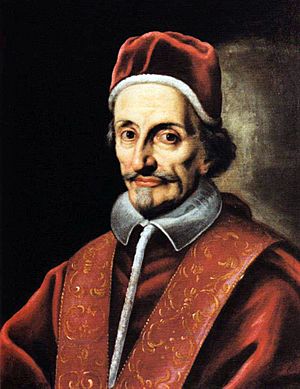
Portrait (1787).
|
|
| Pope; Confessor | |
| Born | Benedetto Odescalchi 16 May 1611 Como, Lombardy, Duchy of Milan |
| Died | 12 August 1689 (aged 78) Apostolic Palace, Rome, Papal States |
| Venerated in | Roman Catholic Church |
| Beatified | 7 October 1956, Saint Peter's Basilica, Vatican City by Pope Pius XII |
| Feast | 12 August 13 August (Hungary) |
| Attributes | Papal attire Papal tiara Camauro |
| Patronage | Diocese of Novara Diocese of Como Bavarian Congregation |
The process to declare Innocent XI a saint began in 1691. It was continued by later Popes but was stopped several times due to political reasons and accusations. In the 20th century, the process started again. Pope Pius XII declared him "Venerable" in 1955 and "Blessed" on October 7, 1956.
After he was declared Blessed, his coffin was placed under the Altar of St. Sebastian in St. Peter's Basilica. In 2011, it was moved to the Altar of Transfiguration to make way for the remains of Pope John Paul II. Innocent XI's monument is across from this altar.
His feast day is celebrated on August 12, the day he died. In Hungary, it is celebrated on August 13.
Encyclicals
- Sollicitudo pastoralis (About Fostering and Preserving Religious Orders)
- Coelestis Pastor (Condemning the errors of Molinos)
See also
 In Spanish: Inocencio XI para niños
In Spanish: Inocencio XI para niños
- Cardinals created by Innocent XI
- Odescalchi


